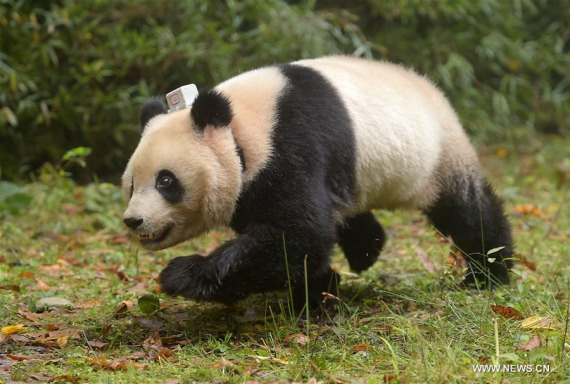
Giant panda Zhang Meng is released into the wild at Liziping Nature Reserve in Ya'an, southwest China's Sichuan Province, Oct. 20, 2016. (Photo: Xinhua/Xue Yubin)
As the cages opened, Hua Yan and Zhang Meng did not hesitate and ran into the wild. The two pandas disappeared into the mountains within seconds.p China released its sixth and seventh pandas at the Liziping Nature Reserve in southwest China's Sichuan Province Thursday morning, in an attempt to diversify the species' genetic pool.
"Releasing them to the wild is just the beginning. We will continue to monitor them and see whether they can survive in the wild," said Huang Yan, a panda reintroduction specialist. "What we are most looking forward to is whether they can mate and breed in the wild."
With a consensus on giant panda protection reached at the International Conference on Giant Panda Conservation that finished Friday, global efforts on panda protection are set to be strengthened.
REINTRODUCTION ENDEAVOR
According to Huang, releasing pandas back into the wild is not easy. It is a complicated process involving many twists and even failure.
The China Conservation and Research Center for the Giant Panda (CCRCGP) started its reintroduction program in 2003, releasing its first captive-bred panda Xiang Xiang into the wild in 2006.
However, Xiang Xiang died roughly a year later after fighting with wild pandas for food and territory. In 2014, Xue Xue, the fourth captive panda to be released, died of illness a month after being released.
Zhang Hemin, the CCRCGP director, came under criticism for sending pandas into the danger of the wild.
But Zhang did not back down.
"The purpose of captive breeding is to keep the number of pandas at a stable level; as a species they belong to the wild," Zhang said.
Under cooperative programs with 10 countries, including the United States, Japan and Belgium, 32 pandas now live in overseas zoos.
"Pandas are adorable, and people love them. But they are not pets, and they should go back to the wild. And the process of captive breeding, wild training and releasing is a road that must be travelled," Zhang said.
"The whole reintroduction program is an experiment. Putting pandas back into the wild is a very complicated process," said David Wildt, head of the Center for Species Survival at the Smithsonian's National Zoo in Washington D.C.
Despite the setbacks, the CCRCGP is continuing its release program. The center released Tao Tao (a male) in 2012, Zhang Xiang (a female) in 2013, and Hua Jiao (a female) in 2015.
"Zhang Xiang has established her own territory, which is an important step to surviving in the wild," Huang said. "Tao Tao and Zhang Xiang have adapted to the wild, and they are expected to naturally mate and breed in the next two to three years."
"They do not just release the animal. There is work before it is released, while it is being released and after it is released. So they learn and they can build on that data, so next time they can release it more successfully. They are learning from each of the reintroductions," Wildt said.


















































